Third-party reporting of offences
Cycling remains a very safe way of getting around Gloucestershire. However, some drivers can be aggressive, or ignorant of the law and Highway Code, and you may encounter behaviour that is risky or which discourages others from cycling, such as close passes and mobile phone usage.
If you wear or mount an ‘action’ camera whilst riding (or use a dashcam whilst driving), you can submit video footage to Gloucestershire Police which they can review to take action against a dangerous motorist. Third party reporting can help local forces detect and respond to criminal behaviour, and encourages everyone to drive safely and appropriately around other highway users.
Whilst our local force doesn’t use Nextbase (a common reporting platform), you can submit video via their Operation Snap (#opsnap) portal, or Gloucestershire Constabulary’s usual evidence submission form.
Article updated January 2023 with Operation Snap submission information
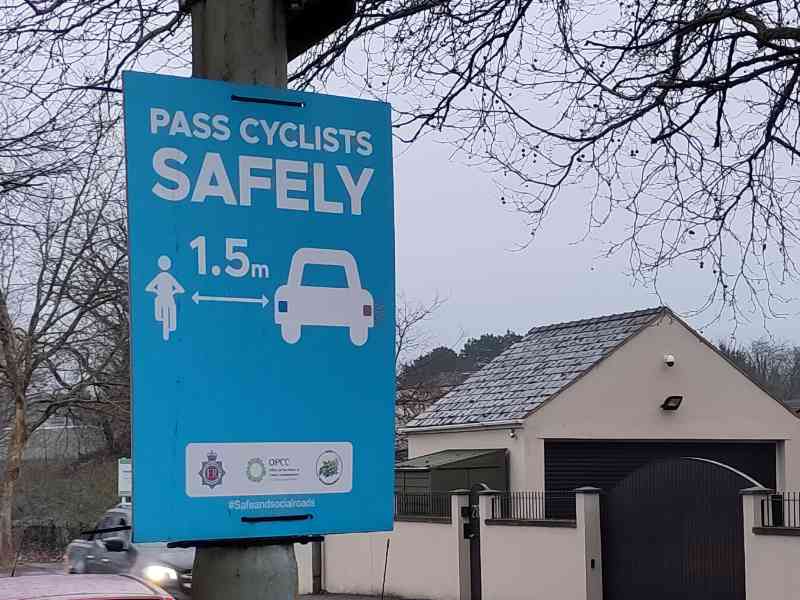
Common offences you might want to pass on include;
- ‘Close passes’, where a driver fails to give you adequate space when overtaking, or squeezes you to the side of the road as it narrows.
- Hooks, where a driver turns across your lane of travel into a side road or pulls out dangerously into the path ahead of you.
- Mobile phone usage, either whilst moving or stationary in traffic (ie not parked)
- Driving through red lights / one way signs, or other similar illegal manoeuvres.
What video do I need to report an incident to the police in Gloucestershire?
To submit your footage, you will need it to;
- Include the 2 minutes before and the 2 minutes after the incident (this is a local requirement, not part of the law).
- Have sufficient detail to identify the vehicle (eg readable number plate).
- Have the approximate time and date the footage was taken.
- Either have time to upload the footage during the submission process (for Opsnap), or have the footage already uploaded to a file repository or video site (eg a private youtube video) with a link you can share.
- Note, if using the general submission form, Gloucestershire police automatically converts the URL to uppercase characters, so will break the link for some filesharing services (eg Dropbox). You should repeat the link in the text, or use a service where this is not a problem. (Thanks to @BikeMcBikeface for noting)
- You should not share the footage or images from it publicly until the police process is fully complete.
You can also file a report without footage, but a prosecution is much less likely to be successful unless there are sufficient witnesses and concern.
Method 1: Submitting a recording to the police following a close pass or similar incident using the OpSnap (Operation Snap) form
Gloucestershire police introduced Operation Snap (#opsnap) in late 2022. This is meant to provide a more streamlined and dedicated process for submitting dashcam, mobile phone camera and cycle camera recordings of driving offences, including close passes.
You’ll need to allow at least 10 minutes to make your submission. Whilst it does take some time, remember the evidence you provide needs to be sufficient for the police to take action.
1. Visit the Gloucestershire police website and navigate to Operation Snap (Information page / Submission form)
2. Confirm you are happy to provide a statement, be asked to attend court, and that your own behaviour will also be scrutinised in the video (ie if using a mobile phone whilst driving to record an incident)
3. Complete your personal details
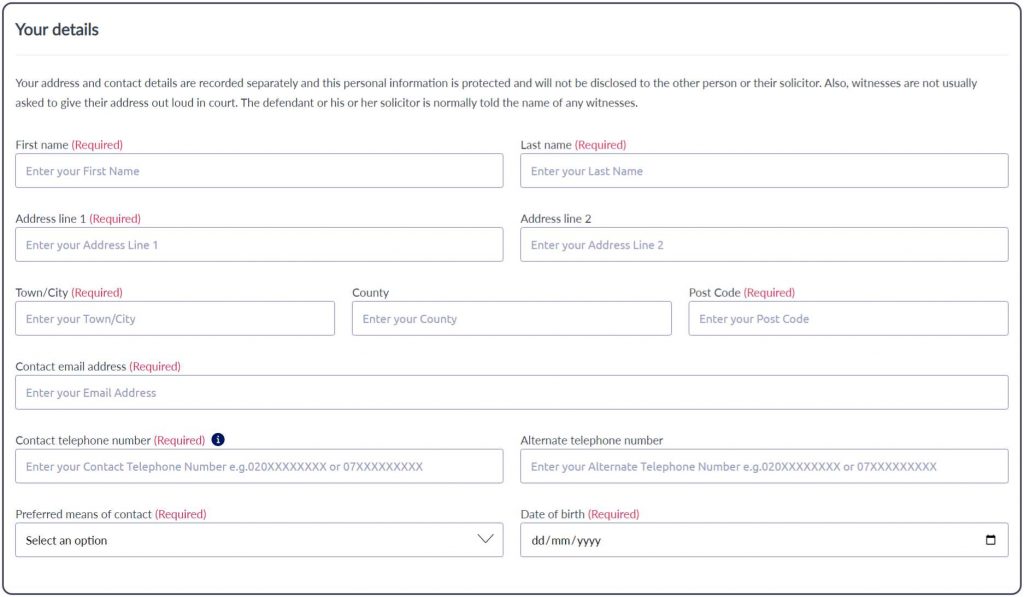
4. Provide some additional details on the incident, including the relative movement of the vehicles and people involved, and then a simple statement of the offence you witnessed. Example text is provided on the submission form. You will also need to state the type of device you recorded the footage on, and how it stores this footage (eg on SD card).
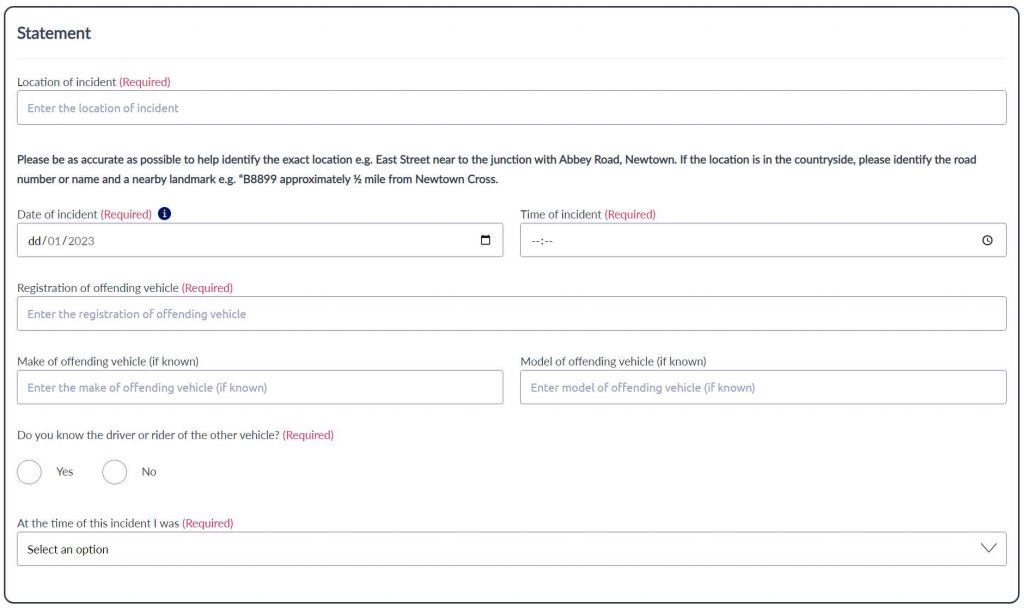
You also need to state the time of the incident, and it is preferable if your footage includes a date/time stamp, although you can derive it from other sources (fitness tracking/calendar)
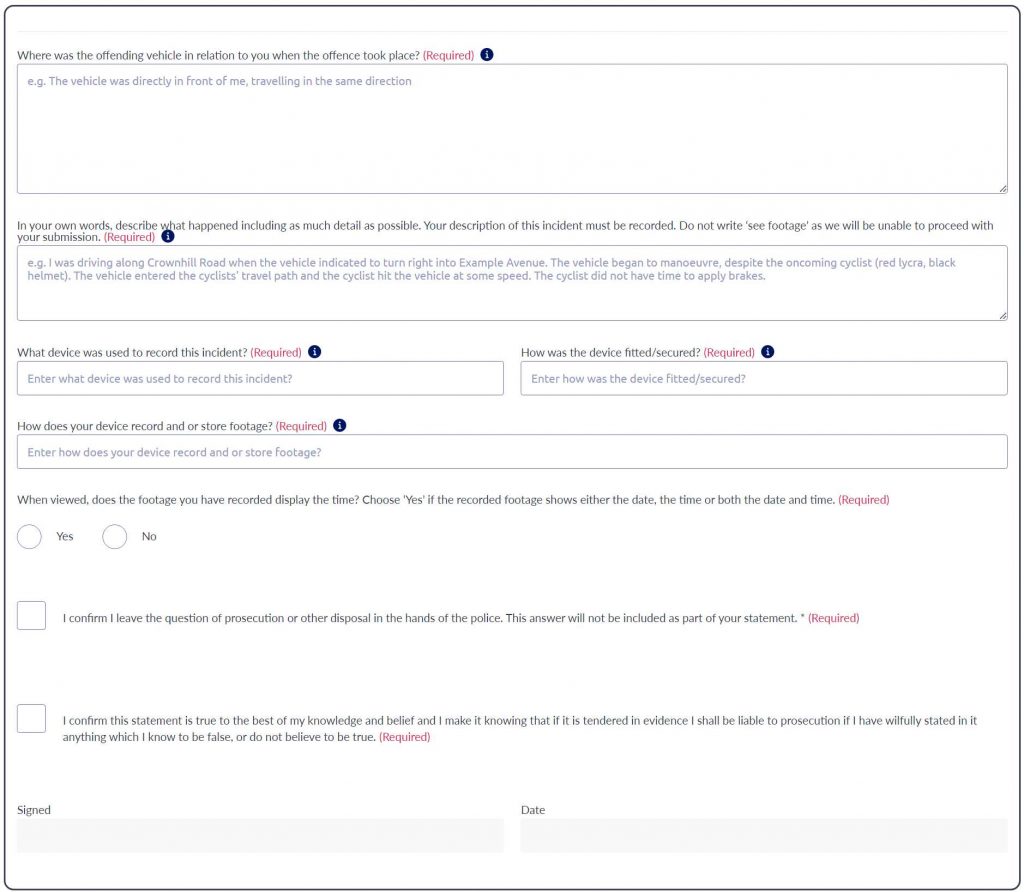
5. You can then upload your footage. As described above, this should include 2 minutes before and after the incident, and you should retain a local copy of the footage as well on the device/memory card.
You are not allowed to submit footage with offensive language, although it is acceptable to record footage without sound recording turned on.
6. You’re then required to give your consent for your details to be handled and released to enable the offence to be appropriately handled and potentially prosecuted.
One of the consents you are required to agree with is ‘The release of my Contact Details For Civil Litigation Purposes(Required)’. We have sought clarification from Gloucestershire Police on this, and have been advised that ‘the tick box provided is in relation to the portal being used for submission of evidence for potential Road Traffic Collisions in the future. We do not currently use this portal for this type of offence but the option to provide consent for disclosure is present in preparation for this.’ We have suggested to Gloucestershire Police that this is either removed from the form or addressed in the FAQs.
7. Click submit. Note that as you are uploading unedited footage, the process may take some time to complete.
Method 2: Submitting a recording to the police following a close pass or similar incident using standard form
You’ll need to allow at least 15 minutes to make your submission. Whilst it does take some time, remember the evidence you provide needs to be sufficient for the police to take action.
1. Visit the Gloucestershire police website and navigate to report a road traffic incident.
2. Use the map to first of all zoom in on the location, and then click and drag to reposition the pin to the exact location.
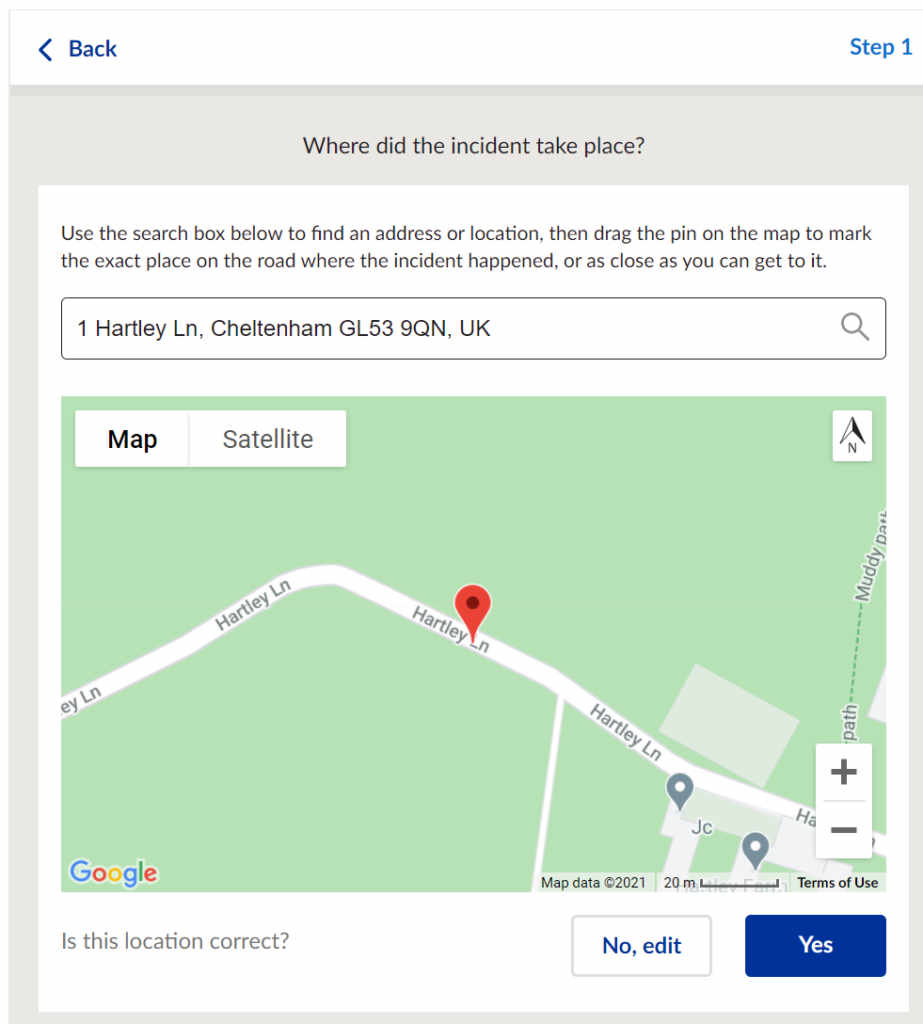
3. Hopefully, you then just need to confirm no collision occurred.
4. Identify the type of offence you believe occurred – this would usually be ‘a possible driving offence’
5. Identify how long it is since the incident happened. Note that it is much easier for the police to take action if it is reported within 10 days.
6. Confirm you have footage available of the incident, and you can then proceed to the main submission form.
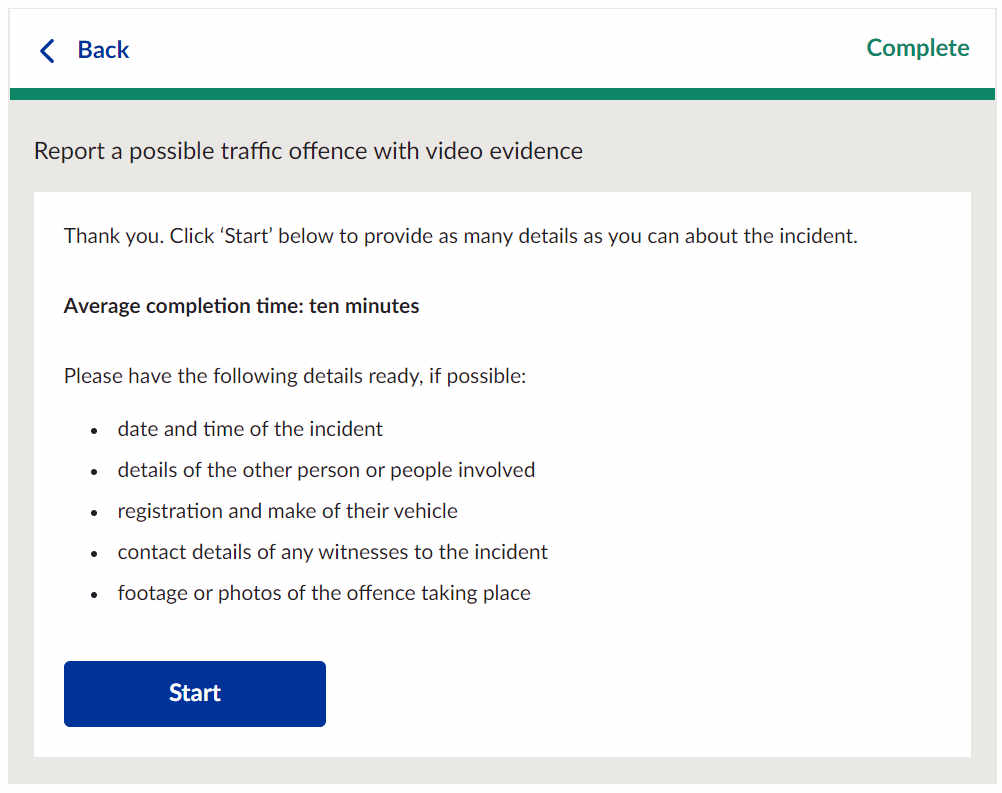
7. You’ll then be taken to the main submission form, where you can provide the full details of the incident. Each section is self explanatory, but in brief, you will need to provide;
- Your details; you must be willing to be identified, as you are making a witness statement
- Your role in the incident; (that you were a cyclist)
- Details of the other people involved in the incident; this would usually be the details of the vehicle that showed the dangerous or illegal behaviour. Your footage should show the number plate, but you can help the police by checking the precise details using the DVLA vehicle enquiry service. You don’t need to know the details of the driver, but any details can help.
- Details of the incident. It’s important here to give as much detail as you can – which way were you heading along the road etc, what was the visibility and weather like, what lights/reflectors were on your cycle etc. Stick to factual information, but be as clear as possible on how you were riding.
8. You can then highlight the appropriate road traffic offenses you believe were committed. You can select more than one (eg Careless or inconsiderate driving AND Cycling close pass)
9. Finally, you need to provide details of how you obtained the footage (eg ‘Helmet mounted camera’), and provide the link to where you have put the footage. You can then write a description of what is shown in the video. You can highlight, for example, that you had appropriate road position, make an estimate of the distance of the pass etc.
10. You can then submit your report. Thank you for helping support the local police to promote safe and legal driving across Gloucestershire. Keep a record of the reference number, and don’t be afraid to use the contact us form to ask for an update on what happened with your report after a couple of months. (Remember it will take some time for the police to contact the vehicle owner, identify the driver, and agree the course of action)
More information on close passes
The video below shows how a close passes education campaign highlighting the importance of drivers giving cyclists sufficient space when passing. You can read more here.
